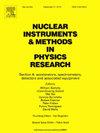Could we efficiently operate 3D silicon pixel-based tracking detectors irradiated with neutron fluences up to 1⋅10181MeVneqcm−2?
IF 1.4
3区 物理与天体物理
Q3 INSTRUMENTS & INSTRUMENTATION
Nuclear Instruments & Methods in Physics Research Section A-accelerators Spectrometers Detectors and Associated Equipment
Pub Date : 2025-06-25
DOI:10.1016/j.nima.2025.170761
引用次数: 0
Abstract
Future new high luminosity colliders will require exceptionally radiation tolerant detectors, in particular those that will be closer to the interaction regions, i.e. tracking and vertexing detectors. 3D trench pixel sensors developed by the TimeSPOT R&D project have shown an incredible time resolution of about 10 ps and radiation hardness up to . To push these limits further, a new irradiation campaign has recently been completed at the TRIGA Mark II Reactor at the Jožef Stefan Institute, reaching extreme fluences of . To evaluate the post-irradiation performance, a dedicated Transient Current Technique (TCT) setup has been developed at the INFN Cagliari laboratories, employing a laser system for controlled energy deposition with a micro-metric spatial accuracy, within the sensors. The TCT characterizations show a complete recovery for the charge collection efficiency (CCE) for the which is compatible to what was measured on a recently conducted beam test by using minimum ionizing particles. However, sensors irradiated to the highest fluences exhibit an incomplete recovery of CCE at the tested bias (up to 400 V) suggesting that even higher bias voltages will be necessary to optimize charge collection and detection efficiency under such extreme condition.
在中子辐照强度高达1⋅10181MeVneqcm−2的情况下,能否有效运行基于硅像素的三维跟踪探测器?
未来新的高亮度对撞机将需要特别耐受辐射的探测器,特别是那些更靠近相互作用区域的探测器,即跟踪和顶点探测器。由TimeSPOT R&;D项目开发的3D沟槽像素传感器显示出令人难以置信的时间分辨率约为10 ps,辐射硬度高达1⋅10171MeVneqcm−2。为了进一步突破这些极限,最近在Jožef Stefan研究所的TRIGA Mark II反应堆上完成了一项新的辐照运动,达到了1⋅10181MeVneqcm−2的极端影响。为了评估辐照后的性能,INFN卡利亚里实验室开发了专用的瞬态电流技术(TCT)装置,该装置采用激光系统在传感器内以微米级空间精度控制能量沉积。TCT表征表明,1⋅10171MeVneqcm−2的电荷收集效率(CCE)完全恢复,这与最近通过使用最小电离粒子进行的束流测试相兼容。然而,在最高影响下辐照的传感器在测试偏置(高达400 V)下显示不完全恢复CCE,这表明在这种极端条件下,需要更高的偏置电压来优化电荷收集和检测效率。
本文章由计算机程序翻译,如有差异,请以英文原文为准。
求助全文
约1分钟内获得全文
求助全文
来源期刊
CiteScore
3.20
自引率
21.40%
发文量
787
审稿时长
1 months
期刊介绍:
Section A of Nuclear Instruments and Methods in Physics Research publishes papers on design, manufacturing and performance of scientific instruments with an emphasis on large scale facilities. This includes the development of particle accelerators, ion sources, beam transport systems and target arrangements as well as the use of secondary phenomena such as synchrotron radiation and free electron lasers. It also includes all types of instrumentation for the detection and spectrometry of radiations from high energy processes and nuclear decays, as well as instrumentation for experiments at nuclear reactors. Specialized electronics for nuclear and other types of spectrometry as well as computerization of measurements and control systems in this area also find their place in the A section.
Theoretical as well as experimental papers are accepted.

 求助内容:
求助内容: 应助结果提醒方式:
应助结果提醒方式:


